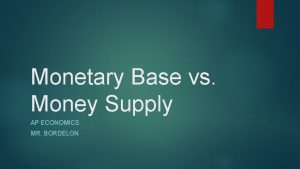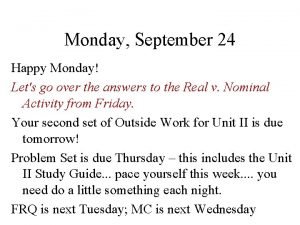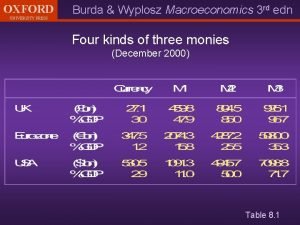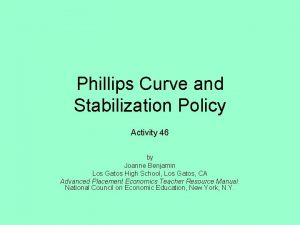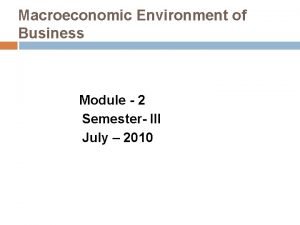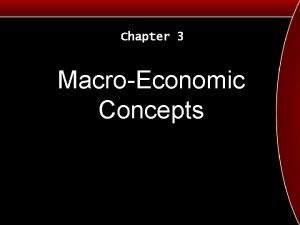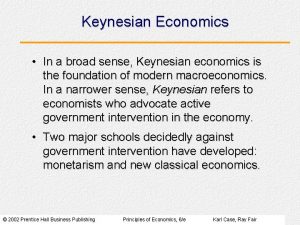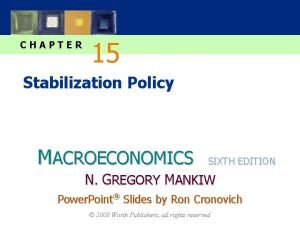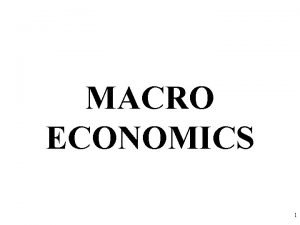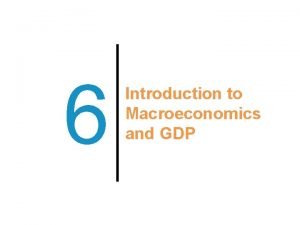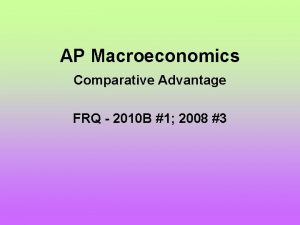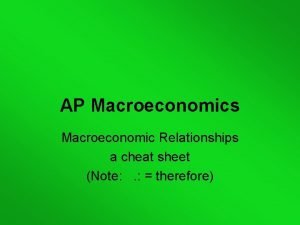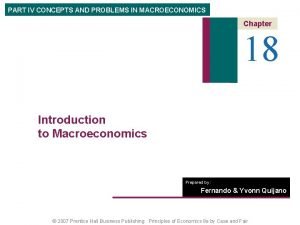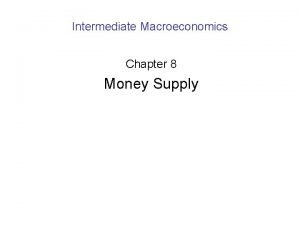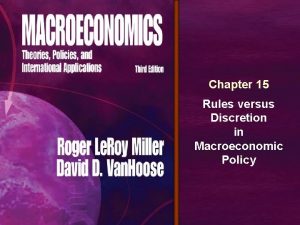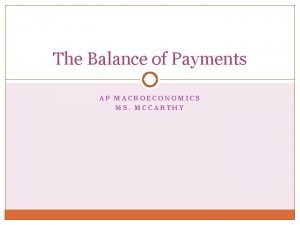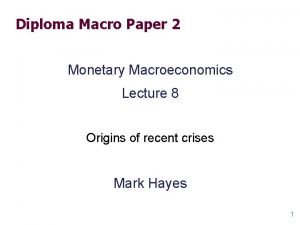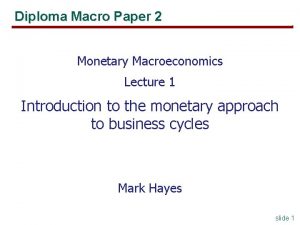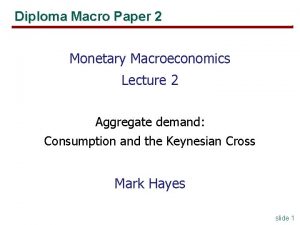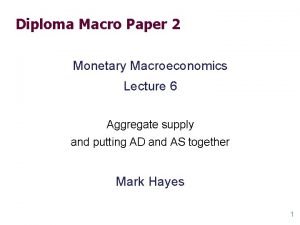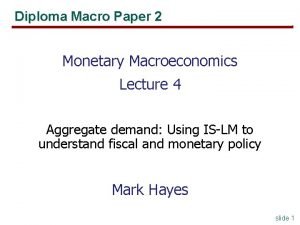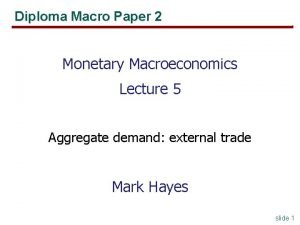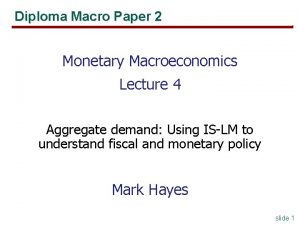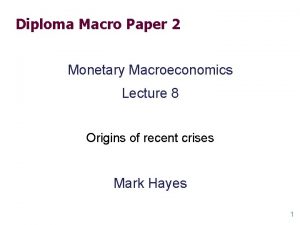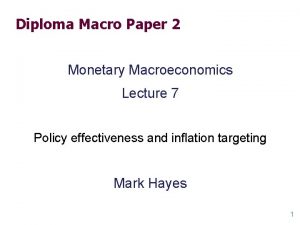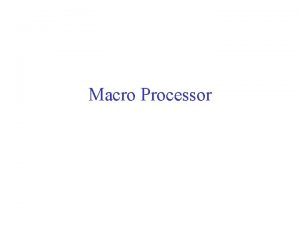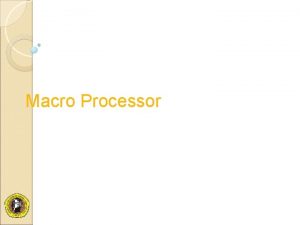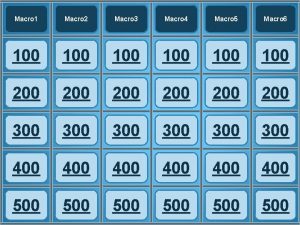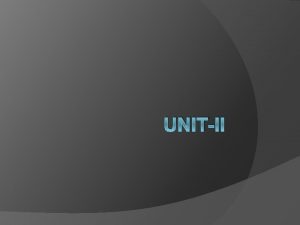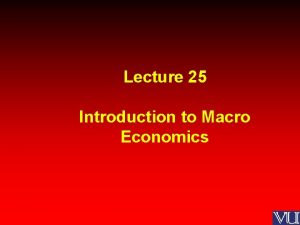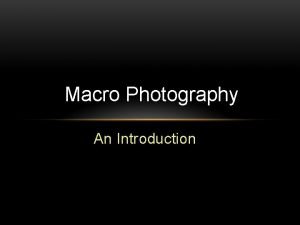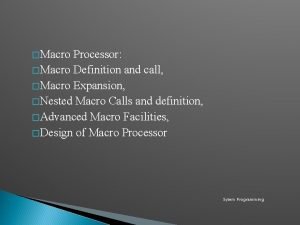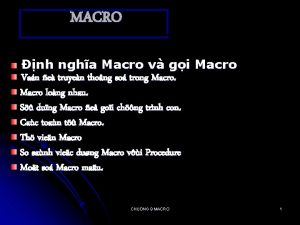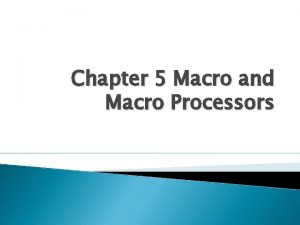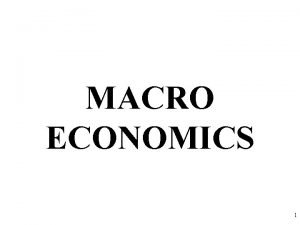Diploma Macro Paper 2 Monetary Macroeconomics Lecture 3


























- Slides: 26

Diploma Macro Paper 2 Monetary Macroeconomics Lecture 3 Aggregate demand: Investment and the IS-LM model Mark Hayes slide 1

Outline § Introduction § Map of the AD-AS model § This lecture, continue explaining the AD curve § Last time, Step 1: Equilibrium with variable income and consumption – the Keynesian Cross § Step 2: Equilibrium with variable income, consumption and investment – the IS-LM model § This lecture highly theoretical, we look at the data with the help of the model next time slide 2

Exogenous: M, G, T, i*, πe Goods market KX and IS (Y, C, I) Phillips Curve ( , u) Labour market (P, Y) AS AD-AS (P, i, Y, C, I) Money market (LM) (i, Y) Foreign exchange market (NX, e) IS-LM (i, Y, C, I) AD IS*-LM* (e, Y, C, NX) AD*-AS (P, e, Y, C, NX)

Exogenous: M, G, T, πe Goods market KX and IS (Y, C, I) Phillips Curve ( , u) Labour market (P, Y) AS AD-AS (P, i, Y, C, I) Money market (LM) (i, Y) Foreign exchange market (NX, e) IS-LM (i, Y, C, I) AD IS*-LM* (e, Y, C, NX) AD*-AS (P, e, Y, C, NX)

The IS curve Definition: a graph of all pairs of i and Y that result in goods market equilibrium i. e. value of output Y = expected expenditure E Expected consumption C is an increasing function of income Y, as in the Keynesian Cross PLUS: Expected investment I is now a decreasing function of the money rate of interest i The equation for the IS curve is: slide 5

Money and real interest rates Mankiw uses r to mean both nominal (money) and real interest rates. This confuses the Classical and Keynesian models. In a monetary model, only the money rate (i) exists as a causal variable. The real interest rate only exists in a corn model. What does exist in a monetary model is the expected rate of inflation e. This is exogenous here. Investment depends on i - e For clarity always use i in a monetary model slide 6

A note on curve shifting A curve (or line) in a diagram is a relationship between two endogenous variables Movement along the curve shows how one variable changes if the other does We are mainly interested in comparing equilibrium positions, how the point of intersection moves A change in an exogenous variable shifts a curve, which moves the equilibrium position Movement along a curve only happens in disequilibrium and may not be realistic slide 7

The investment demand curve i Spending on investment goods is a downwardsloping function of the interest rate I (i) I slide 8

The investment demand curve i e 2 > e 1 I (i, e 2) I (i, e 1) I slide 9

Deriving the IS curve E =Y E E =C +I (i 1 )+G i I E Y E =C +I (i 2 )+G I i Y 1 Y Y 2 i 1 i 2 IS Y 1 Y 2 Y slide 10

Shifting the IS curve: G At any value of i, G E =Y E E =C +I (i 1 )+G 2 E =C +I (i 1 )+G 1 E Y …so the IS curve shifts to the right. The horizontal distance of the IS shift equals i Y 1 Y Y 2 i 1 Y Y 1 IS 1 Y 2 IS 2 Y slide 11

Shifting the IS curve: T At any value of i, E =Y E T C E E =C 1 +I (i 1 )+G E =C 2 +I (i 1 )+G …so the IS curve shifts to the left. The horizontal distance of the IS shift equals i Y 2 Y Y 1 i 1 Y Y 2 IS 2 Y 1 IS 1 Y slide 12

The short-run equilibrium: IS-LM i LM IS Y Equilibrium interest rate Equilibrium level of income slide 13

The money market What determines the money interest rate? NOT the supply and demand for loanable funds! In the monetary model, the interest rate clears the money market, matching the supply and demand for a stock of money In the Classical model, the interest rate clears the loanable funds market, matching the supply and demand for flows of saving for investment Oil and water! slide 14

Money supply The supply of real money balances is fixed: M/P real money balances slide 15

The demand for money slide 16

Money demand (holding Y constant) Demand for real money balances: M/P real money balances slide 17

Equilibrium (holding Y constant) The interest rate adjusts to equate the supply and demand for money: M/P real money balances slide 18

Central Bank can raise the interest rate § M/P real money balances slide 19

The LM curve is a graph of all combinations of i and Y that equate the supply and demand for real money balances. The equation for the LM curve is: slide 20

Deriving the LM curve (a) The market for i real money balances (b) The LM curve i LM i 2 i 1 i 2 L (i , Y 2 ) i 1 L ( i , Y 1 ) M/P Y 1 Y 2 Y slide 21

How M <0 shifts the LM curve (a) The market for i real money balances (b) The LM curve i LM 2 LM 1 i 2 i 1 L ( i , Y 1 ) M/P Y 1 Y slide 22

The short-run equilibrium: IS-LM The short-run equilibrium is the combination of i and Y that simultaneously satisfies the equilibrium conditions in the goods & money markets: (IS) i LM IS Y (LM) Equilibrium interest rate Equilibrium level of income slide 23

Deriving the AD curve Intuition for slope of AD curve: P (M/P ) LM shifts left I LM(P 1) i 2 i 1 IS i LM(P 2) i P Y 2 Y 1 Y P 2 P 1 Y AD Y 2 Y 1 Y slide 24

Summary We have derived the AD curve as a set of pairs of P and Y consistent with simultaneous equilibrium in the goods and money markets The building blocks of the AD curve are the Keynesian Cross and the IS-LM model We now have four endogenous variables: Y, C, I and i Exogenous variables include P, M, G and T slide 25

Next time § Applying the IS-LM model: – Fiscal policy – Monetary policy § Revise this lecture and make sure you understand how the model works before the next lecture! § Especially: consider the meaning of different slopes of the IS and LM curves slide 26
 Monetary base vs money supply
Monetary base vs money supply Problem set #2 macro unit 2 macro measures
Problem set #2 macro unit 2 macro measures Macro processor algorithm and data structures
Macro processor algorithm and data structures 01:640:244 lecture notes - lecture 15: plat, idah, farad
01:640:244 lecture notes - lecture 15: plat, idah, farad Aice english paper 2
Aice english paper 2 Aice general paper exam
Aice general paper exam Burda and wyplosz
Burda and wyplosz Aw phillips curve
Aw phillips curve Contractionary fiscal policy interest rate
Contractionary fiscal policy interest rate Macroeconomics ninth edition
Macroeconomics ninth edition Limitations of macroeconomics
Limitations of macroeconomics Macroeconomics deals with?
Macroeconomics deals with? New classical macroeconomics
New classical macroeconomics Intermediate macroeconomics mankiw
Intermediate macroeconomics mankiw Macroeconomics
Macroeconomics Macroeconomics
Macroeconomics What is macroeconomics
What is macroeconomics Growth rate nominal gdp formula
Growth rate nominal gdp formula Comparative advantage frq
Comparative advantage frq Macroeconomics cheat sheet
Macroeconomics cheat sheet Components of macroeconomics
Components of macroeconomics Explain the quantity theory of money
Explain the quantity theory of money N
N Rules vs discretion macroeconomics
Rules vs discretion macroeconomics Ap macroeconomics balance of payments
Ap macroeconomics balance of payments Macroeconomics definition economics
Macroeconomics definition economics Definition of macroeconomics
Definition of macroeconomics
